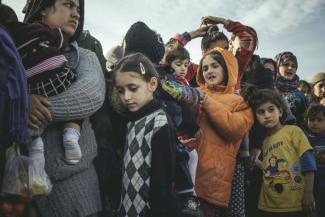Migration
Unaccompanied minor refugees
 Florian Bachmeier/Lineair
Florian Bachmeier/Lineair
Children become refugees for many reasons: war, trauma, poverty, privation, death. Some are separated from their parents on the long trajectory of flight. Others are orphans who want to escape hardship and violence in their homeland. Yet others place themselves in the hands of people traffickers in the hope of reaching a safe place.
Unaccompanied children account for two to three percent of all asylum applications submitted in Central Europe. Between January and September 2017, more than 25,300 children arrived in Greece, Bulgaria and Spain, and over 14,800 (58 %) of them were unaccompanied and lost children. In the third quarter of 2017, the absolute number was 14,800 – about a third more than in the second quarter.
In the first nine months of 2017, Greece and Italy transferred more than 9,800 children to other EU countries. Among them were 329 unaccompanied and lost children. The percentage of boys was higher than girls (an average of 7 boys to every 3 girls).
In the first six months of 2017, the majority of refugee minors submitting applications in Germany were 16 or 17 years old (82 %) and male (86 %). The main countries of origin were Afghanistan (25 %), Eritrea (22 %), Somalia (10 %), Guinea (8 %) and Syria (8 %). The overall acceptance rate – the percentage of refugees confirmed as being entitled to protection – was around 80 %. This was moderately below the 2016 acceptance rate (89 %).
Reliable data on the number of unaccompanied minors arriving or present in European countries tends not to be readily available. The number of asylum applications indicates a trend but does not necessarily supply a precise picture . This is due to backlogs in national asylum systems, onward migration or refugees failing to submit asylum requests.
Europol believes the true figures are much higher. In 2016, the EU law-enforcement agency reckoned that 27 % of all refugees arriving in Europe were minors. It also pointed out that around 10,000 of the unaccompanied children registered in Europe can no longer be traced. They may have found a home with relatives – or they may have been picked up by criminal gangs who exploit defenceless minors or force them into prostitution.
Mariyana Berket of the Organisation for Security and Co-operation in Europe (OSCE) says that “unaccompanied minors from conflict zones are by far the most vulnerable group of refugees”. (rb)